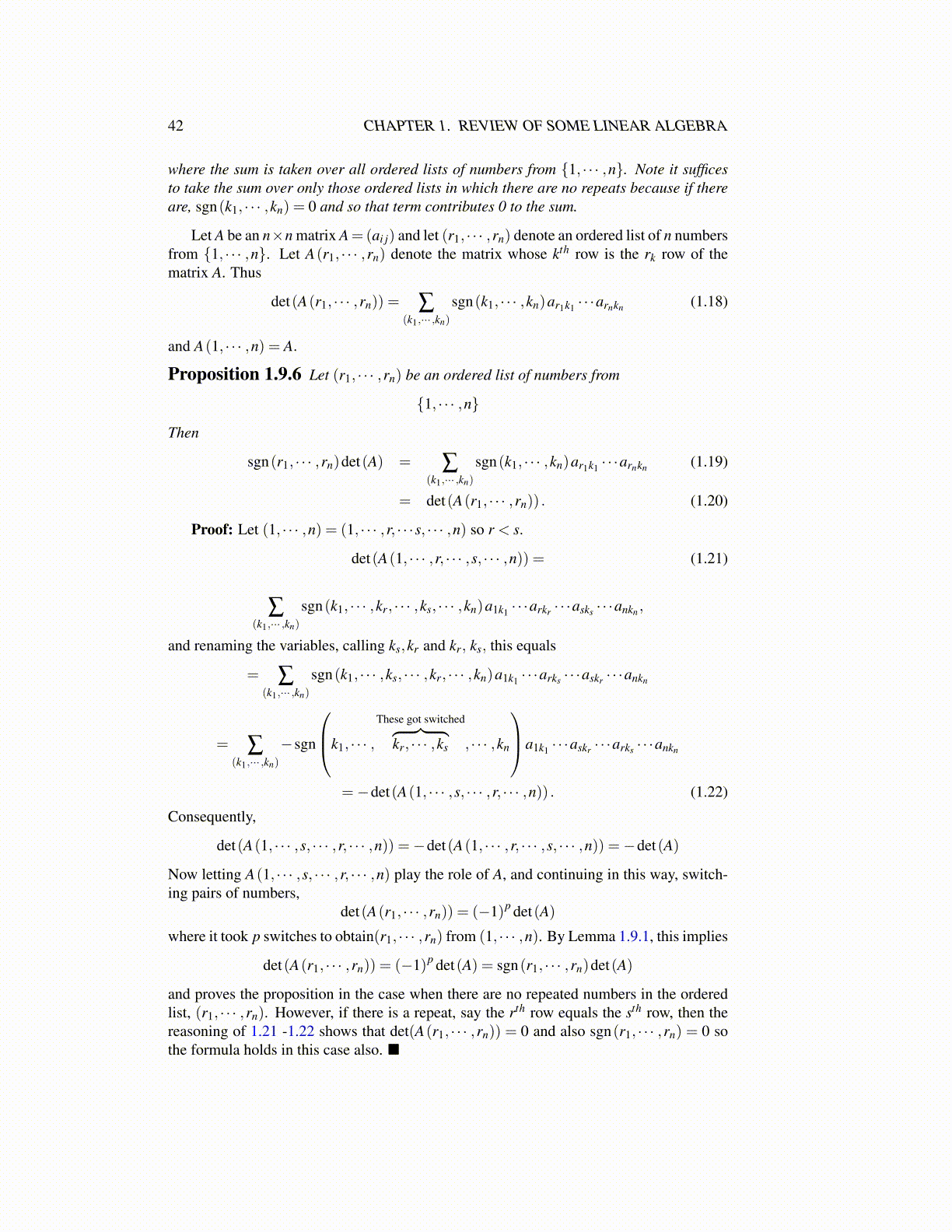
42 CHAPTER 1. REVIEW OF SOME LINEAR ALGEBRA
where the sum is taken over all ordered lists of numbers from {1, · · · ,n}. Note it sufficesto take the sum over only those ordered lists in which there are no repeats because if thereare, sgn(k1, · · · ,kn) = 0 and so that term contributes 0 to the sum.
Let A be an n×n matrix A=(ai j) and let (r1, · · · ,rn) denote an ordered list of n numbersfrom {1, · · · ,n}. Let A(r1, · · · ,rn) denote the matrix whose kth row is the rk row of thematrix A. Thus
det(A(r1, · · · ,rn)) = ∑(k1,··· ,kn)
sgn(k1, · · · ,kn)ar1k1 · · ·arnkn (1.18)
and A(1, · · · ,n) = A.
Proposition 1.9.6 Let (r1, · · · ,rn) be an ordered list of numbers from
{1, · · · ,n}
Then
sgn(r1, · · · ,rn)det(A) = ∑(k1,··· ,kn)
sgn(k1, · · · ,kn)ar1k1 · · ·arnkn (1.19)
= det(A(r1, · · · ,rn)) . (1.20)
Proof: Let (1, · · · ,n) = (1, · · · ,r, · · ·s, · · · ,n) so r < s.
det(A(1, · · · ,r, · · · ,s, · · · ,n)) = (1.21)
∑(k1,··· ,kn)
sgn(k1, · · · ,kr, · · · ,ks, · · · ,kn)a1k1 · · ·arkr · · ·asks · · ·ankn ,
and renaming the variables, calling ks,kr and kr, ks, this equals
= ∑(k1,··· ,kn)
sgn(k1, · · · ,ks, · · · ,kr, · · · ,kn)a1k1 · · ·arks · · ·askr · · ·ankn
= ∑(k1,··· ,kn)
−sgn
k1, · · · ,These got switched︷ ︸︸ ︷
kr, · · · ,ks , · · · ,kn
a1k1 · · ·askr · · ·arks · · ·ankn
=−det(A(1, · · · ,s, · · · ,r, · · · ,n)) . (1.22)
Consequently,
det(A(1, · · · ,s, · · · ,r, · · · ,n)) =−det(A(1, · · · ,r, · · · ,s, · · · ,n)) =−det(A)
Now letting A(1, · · · ,s, · · · ,r, · · · ,n) play the role of A, and continuing in this way, switch-ing pairs of numbers,
det(A(r1, · · · ,rn)) = (−1)p det(A)
where it took p switches to obtain(r1, · · · ,rn) from (1, · · · ,n). By Lemma 1.9.1, this implies
det(A(r1, · · · ,rn)) = (−1)p det(A) = sgn(r1, · · · ,rn)det(A)
and proves the proposition in the case when there are no repeated numbers in the orderedlist, (r1, · · · ,rn). However, if there is a repeat, say the rth row equals the sth row, then thereasoning of 1.21 -1.22 shows that det(A(r1, · · · ,rn)) = 0 and also sgn(r1, · · · ,rn) = 0 sothe formula holds in this case also. ■